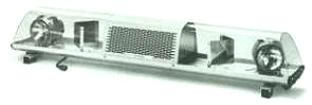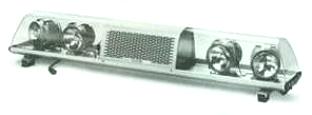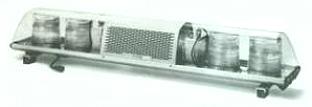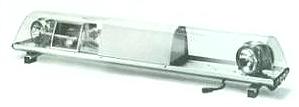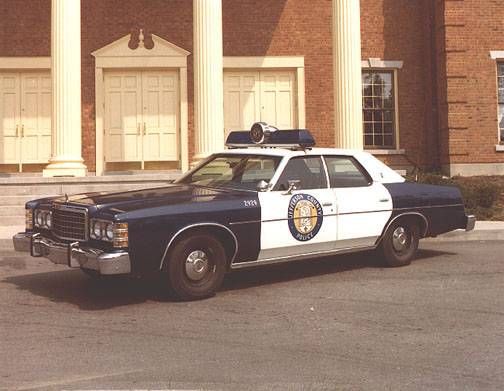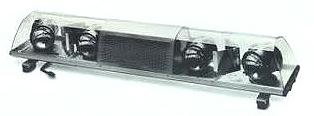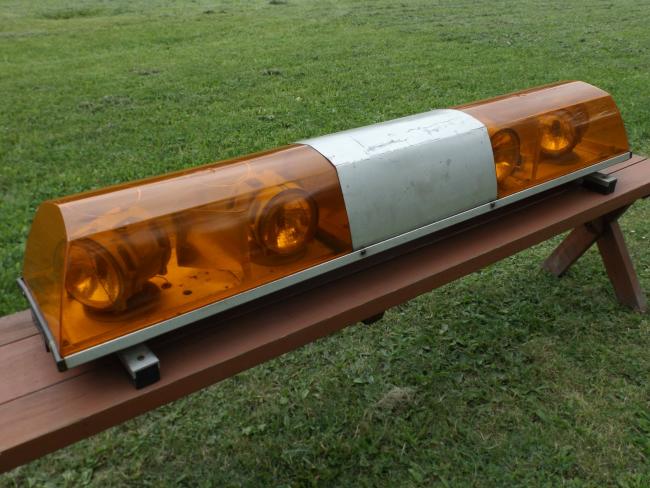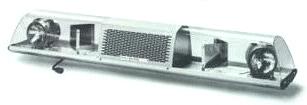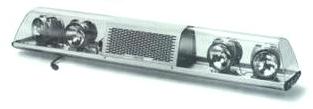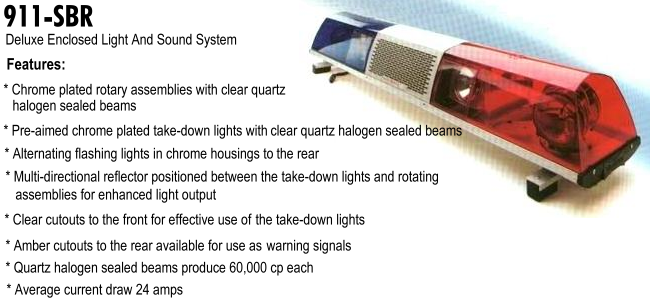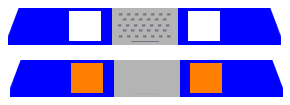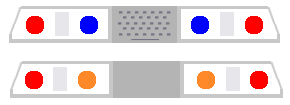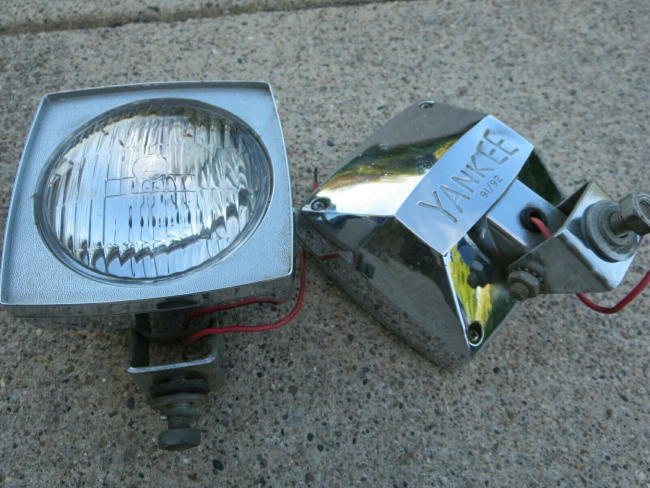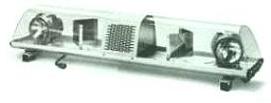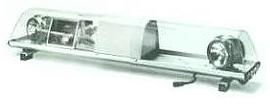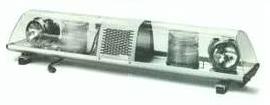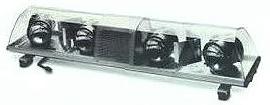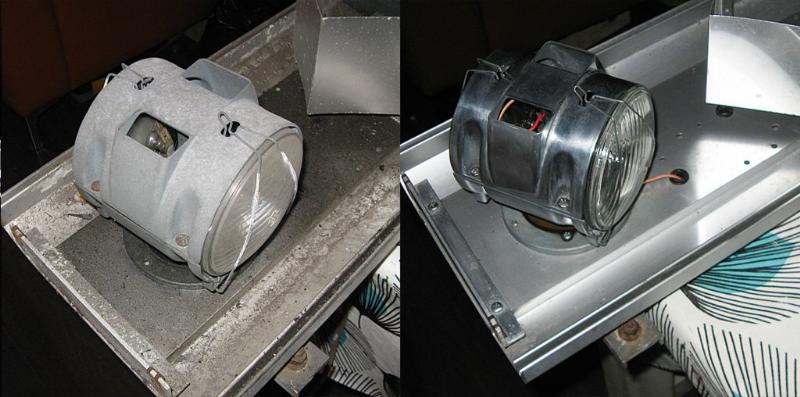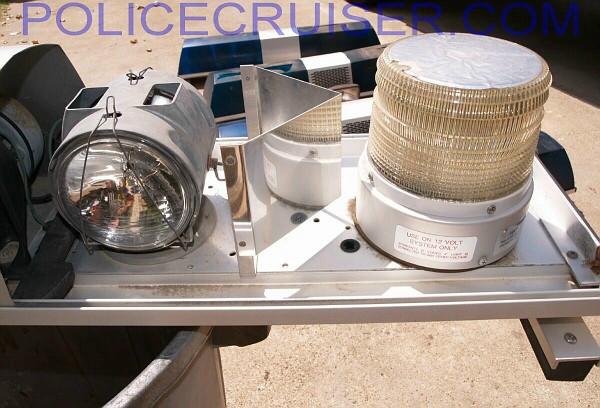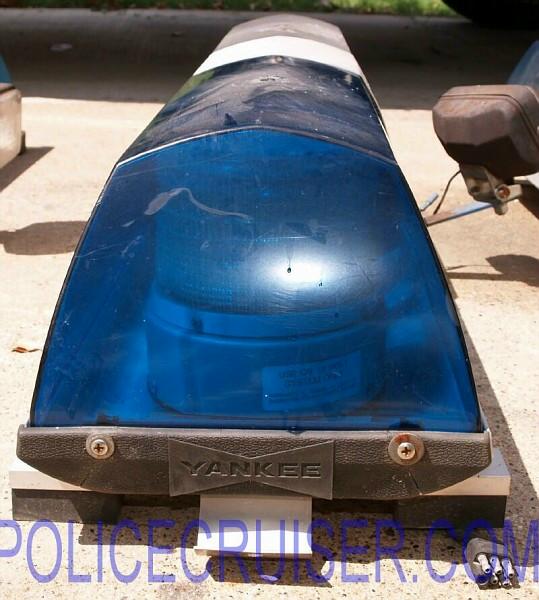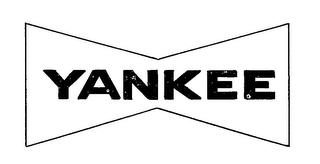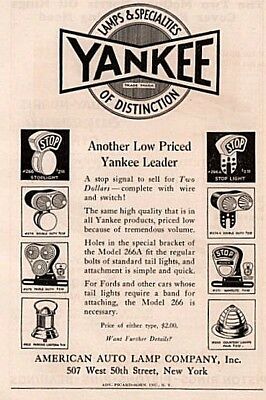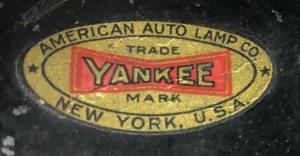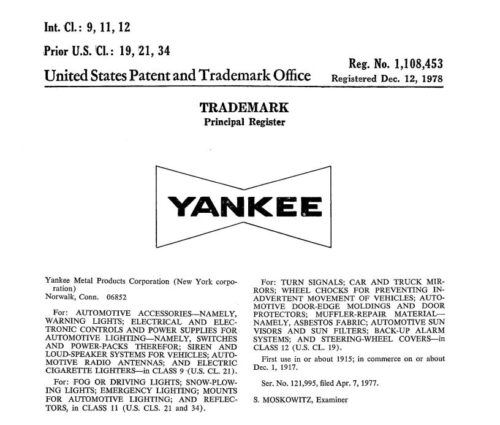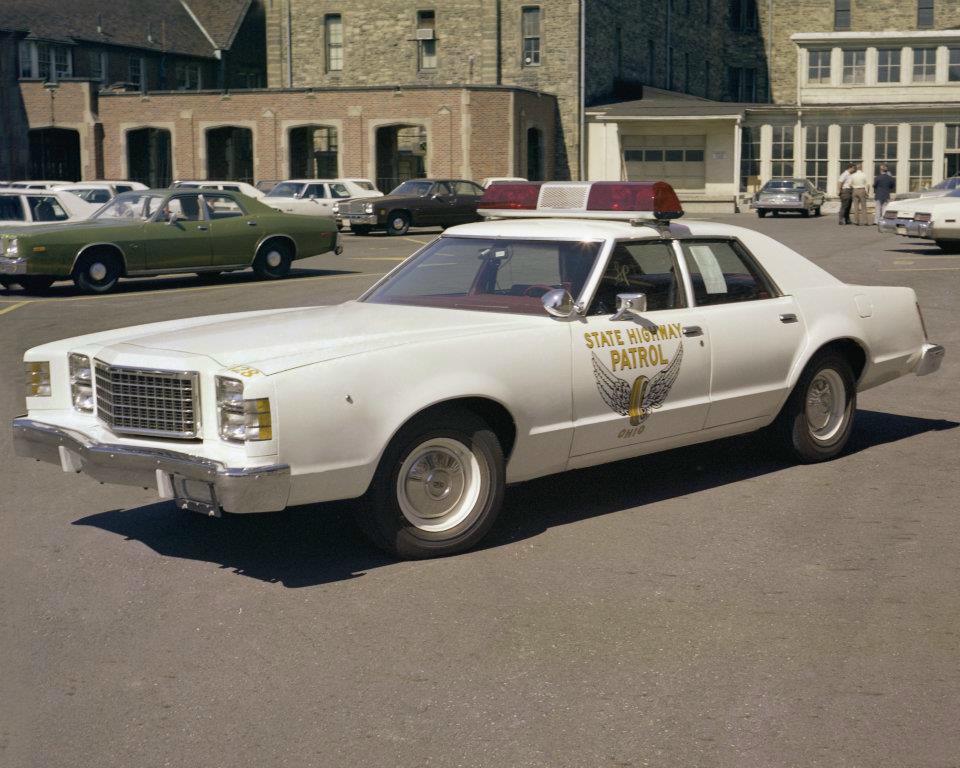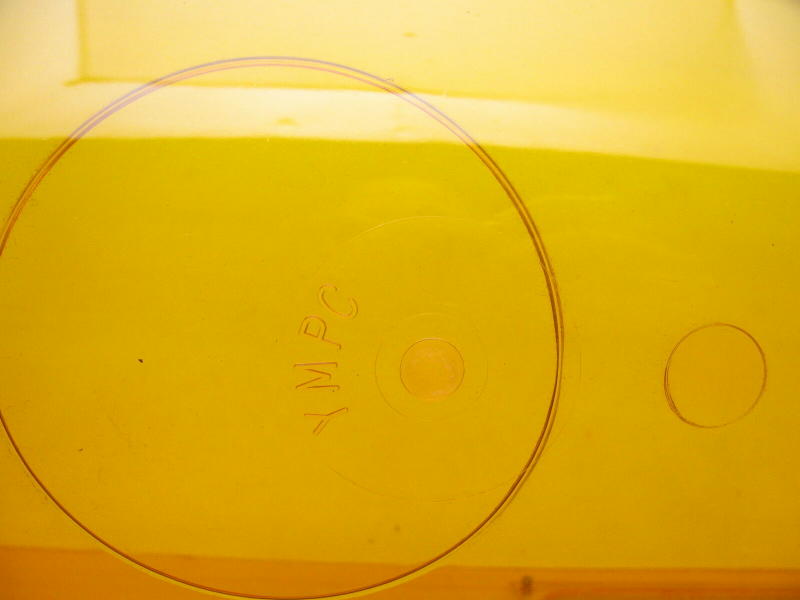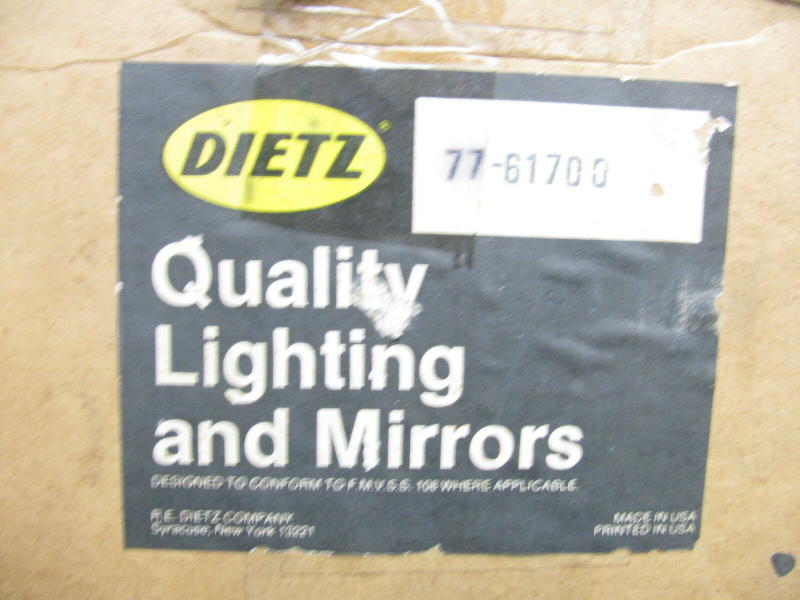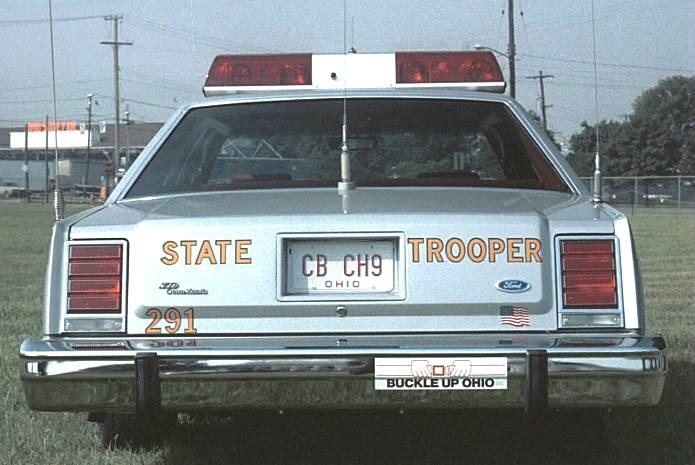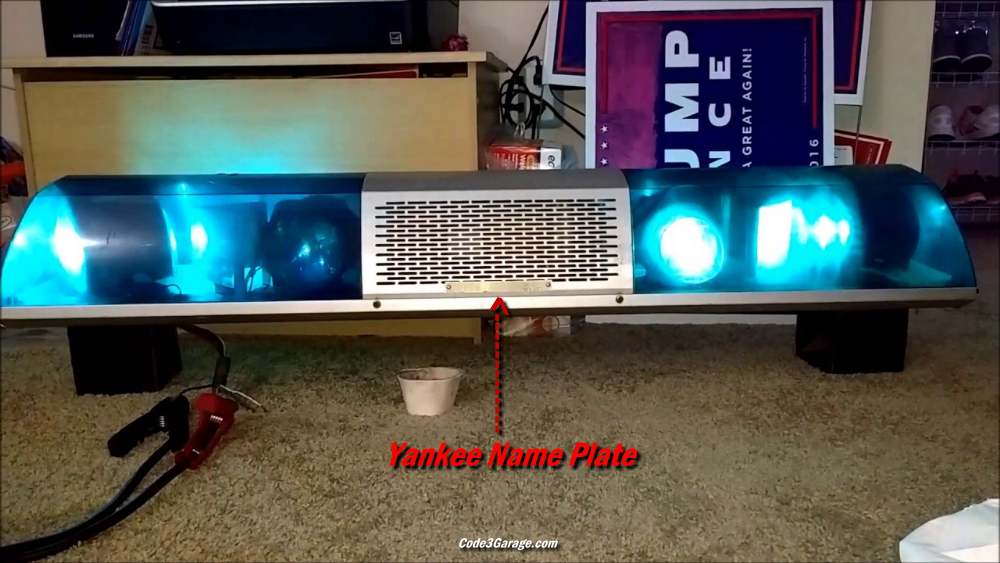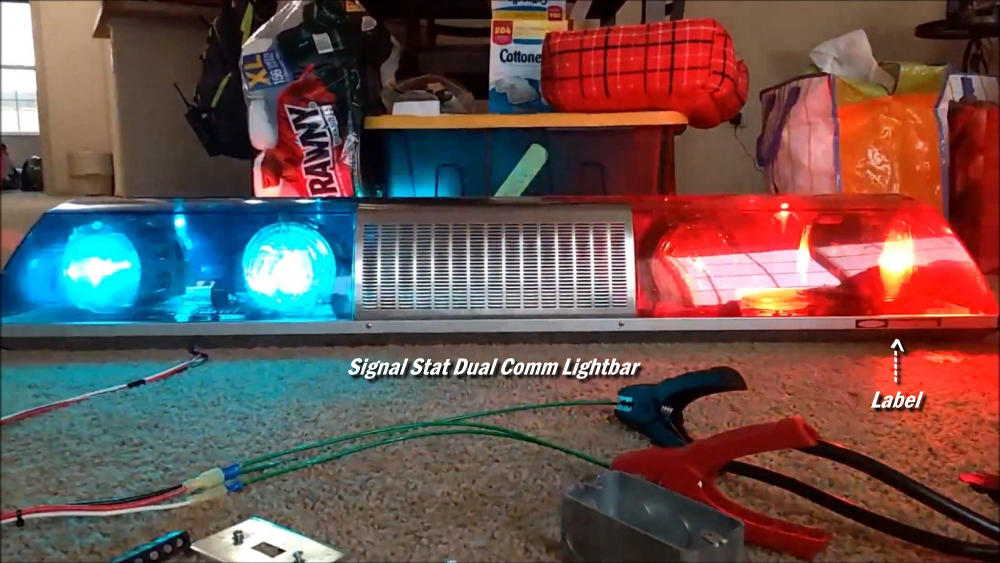(Ohio State Highway Patrol car with a Yankee 911-56 lightbar)
Since the introduction of the YANKEE 911 All Sealed Light and Sound System more and more municipalities are turning to YANKEE for their emergency lighting requirements.
The YANKEE 911 has rounded out what is perhaps the most complete emergency lighting program in the industry today.
With twelve variations to choose from and data proving greater fuel economy, it is no wonder that more municipalities are coming to YANKEE to solve their lighting problems.
- Aerofoil design minimizes wind resistance, improved handling and increase fuel economy
- Aluminum construction for maximum strength, minimum weight
- High impact Lexan domes
- Fits all cars, including wreckers
- Individual motors for rotary lamps
- Easy gutter or gutterless mounting kits supplied
Yankee 911 Basic Units
Yankee 911-50 Lightbar
This assembly consists of two sealed beam rotary lamps located at the outboard positions and two multi-directional aluminum reflectors at the inboard positions. Average current draw 10 amps.
(Yankee 911-50 Lightbar)
Yankee 911-51 Lightbar (Discontinued Reorder 911-56)
Similar to Catalog Number 911-50 except the metal reflectors are replaced by two double-faced alternately flashing sealed beam units controlled by a heavy-duty flasher. Average current draw 14.5 amps.
Yankee 911-52 Lightbar
Both inboard and outboard positions are fitted with two Yankee Double Popper Strobe systems for a total of four. Average current draw 7 amps.
Yankee 911-53 Lightbar (Cal Spec)
A special lightbar designed to meet the requirements of all California law enforcement agencies. Outboard positions are fitted with two sealed-beam rotary lamps, and the inboard drivers side (left) is fitted with a steady burning red lamp facing front and a flashing amber lamp facing the rear. Average current draw 14.5 amps.
Yankee 911-54 Lightbar
This lightbar is similar to the 911-50 except the loudspeaker area has no grill and is open for open speaker installation. Average current draw 10 amps.
(Jefferson County Police (Kentucky) police car with a Yankee 911-54 lightbar and Federal Q-siren)
Yankee 911-55 Lightbar
The outboard positions features two sealed beam rotary lamps and one Solar Strobe system inboard. Average current draw 13.5 amps.
Yankee 911-56 Lightbar (NEW)
(When ordering for California specify 911-57)
An all-light system consisting of two sealed beam rotary lamps in the outboard position plus two double-faced alternately flashing sealed beam units in the inboard position and two multi-directional reflectors between each rotary and flashing lamp.
(Yankee 911-56 Lightbar – Rear)
Yankee 911-60 Lightbar
This assembly consists of two sealed beam rotary lamps located at the outboard positions and two multi-directional aluminum reflectors at the inboard positions. Average current draw 10 amps.
*Wrecker Mounting Base – The bases of the 911-60 and 911-61 have been cut out and mount easily on any wrecker bar and are equipped with sliding anchor plates (part No. 76136).
Yankee 911-61 Lightbar
(When ordering for California specify 911-59)
Same as 911-60 except the metal reflectors are replaced by two double-faced alternately flashing sealed beam units controlled by a heavy duty flasher. Average current draw 14.5 amps.
Yankee 911-SBR Lightbar
911-SBR-1: Enclosed lightbar with red/red domes and two clear cutouts in the front.
911-SBR-2: Enclosed lightbar with blue/blue domes and two clear cutouts in the front.
911-SBR-3: Enclosed lightbar with red/blue domes and two clear cutouts in the front.
911-SBR-4: Enclosed lightbar with blue/red domes and two clear cutouts in the front.
911-SBR-5: Enclosed lightbar with red/red domes, two clear cutouts forwards and two amber cutouts rearward.
911-SBR-6: Enclosed lightbar with blue/blue domes, two clear cutouts forwards and two amber cutouts rearward.
911-SBR-7: Enclosed lightbar with red/blue domes, two clear cutouts forward and two amber cutouts rearward.
911-SBR-8: Enclosed lightbar with blue/red domes, two clear cutouts forward and two amber cutouts rearward.
911-SBR-9: Enclosed lightbar with clear/clear domes. No cutouts. Specify sealed beam colors when ordering. Imagine the possibility below.
The 911-SBR lightbars use the Yankee 91/92 fog light chrome housing.
Yankee 911 Short Bar Series 45-Inches
Yankee 911-30 Lightbar
This assembly consists of two sealed beam rotary lamps located at the outboard position that individually produce 120 flashes per minute. They rotate 360 degrees in a rugged die-cast housing on precision ball bearings. Two multi-directional reflectors. Average current draw 10 amps. Note: When ordering for California, specify 911-38.
Yankee 911-32 Lightbar
Both inboard and outboard position of this model are fitted with two Yankee double popper strobe systems which each give 50 double flashes per minute – up to a 16 watt second primary flash and a 6-watt second secondary flash. Average current draw 7 amps.
Yankee 911-33 Lightbar
This special lightbar was designed to meet the requirements of all California law enforcement agencies. The outboard positions are fitted with two sealed beam rotary lamps (described in 911-31). The inboard drivers side is fitted with a PAR-46 sealed beam with a steady burning red lamp facing front and a PAR-46 sealed beam with a flashing front amber lamp facing rear. Average current draw 14.5 amps.
Yankee 911-35 Lightbar
This bar consists of two sealed beam rotary lamps (described in 911-31) at the outboard position. One double popper strobe system (described in 911-32) at the inboard position. Average current draw 13.5 amps.
Yankee 911-36 Lightbar
An all light system consisting of two sealed beam rotary lamps (described in 911-31) at the outboard position. Two double-faced seal beams bi-directional flashing lights at the inboard position. Both lights are enclosed in rugged die-cast housing and are controlled by heavy-duty flashers providing 90 alternate flashers per minute. Two multi-directional reflectors between each rotary and flashing lamp. Average current draw. 14.5 amps. Note: When ordering for California specify 911-37.
Yankee 911-SBR Lightbar
A deluxe system that includes chrome plated rotary assemblies with clear quartz halogen sealed beams. Alternating flashing lights in chrome housings to the rear. Multi-directional reflector positioned between the take-down lights and rotating assemblies for enhanced light output. Clear cutouts to the front for effective use of the take-down lights. Amber cutouts to the rear available for use as warning signals. Quartz halogen sealed beams produce 60,000 c.p. each. Average current draw 24 amps.
Note: The 911 short bar series are available in nine red, blue, amber, and clear dome variations. For details regarding dome color combinations cutouts and configurations.
Yankee Mini Lightbars
Yankee 911-20 Lightbar
A modular unit, 22 inches long with one dome. It contains two sealed beam rotary lamps. Average current draw 10 amps.
Yankee 911-21 Lightbar
Similar to Catalog Number 911-20 except this modular unit contains a dual Solar Strobe system. Average current draw 3.5 amps.
Yankee Rotators
Here’s a look at a Yankee lightbar that’s been cleaned up in preparation for restoration. You can get a look here at the rotator.
Above is a Yankee lightbar with a double-faced alternately flashing sealed beam unit, a multi-direction reflector, and a strobe. Now imagine that rotator where the strobe is.
This is not an original Yankee lightbar. It’s said that the rotators in the Yankee lightbar were known to go bad, and some agencies converted them to strobe using a strobe conversion kit offered by Lectric Lites . This lightbar was outfitted with two Lectric Lite Astro Flash II (Model LL800- B) strobes.
(Yankee lightbar end cap)
History of Yankee & Dietz
What We Know:
The American Auto Lamp Company was founded in 1915 in New York by Benjamin Putterman for the manufacture of kerosene lamps for automobiles. At some point they began using the name Yankee along with ‘American Auto Lamp Company’ and then simply Yankee Metal Products Corporation. The firm grew rapidly, relocating twice before moving to Norwalk, Connecticut. With the proliferation of the automobile, Yankee was able to continue expanding its product line and production.
(1926 Yankee – American Auto Lamp Company – advertisement)
(Early Yankee logo)
In 1945 the Yankee Metal Products Corporation purchased the Loth building at 25 Grand Street Norwalk Connecticut from the American Hat company. The company constructed two additions on the back of the building, including a plating room, in 1954 and 1958.
When Seymour (Sy) Putterman (son of Benjamin Putterman) entered the family business (Yankee Metal Products Corporation) in 1956, the company was described as “a manufacturer of automotive, bus, and truck accessories in Norwalk”.
Benjamin Putterman died in 1958, and his son Milton Putterman served as President, and his son Harold served as Executive Vice-President. Seymour (Sy) and his brother sold the family business in 1983. When Yankee Metal Products filed a withdrawal on June 14,1985 telling the state that it no longer wished to formally practice business, Seymour’s name and address was listed for the contact.
After the business was sold, the building was purchased by Daseke & Company of Westport, CT. Daeseke applied to have the building entered in to the National Register of Historic Places, and was listed on the registry on May 17, 1984. In 1985 the building was converted in to 132 rental apartments, and later converted in to condominiums in the 2000’s.
(Yankee packaging)
The YANKEE Trademark:
Searching for patents, the earliest use I could find for Yankee Metal Products Corp was in 1927 for a ‘smokers receptacle’. Yankee Metal Products was registered as a corporation on July 20, 1934. It was withdrawn on June 14, 1985. An application to trademark the YANKEE logo (below) was filed on April 7, 1977 and it was registered on December 12, 1978.
(YANKEE Trademark – Click to enlarge)
On December 5th 1984, the YANKEE trademark was sold to Latch-Gard INC in Elkhart, Indiana.
On December 10, 1984 Yankee filed an “Affidavit of Incontestability” (“Section 15” Affidavit). If the mark is registered on the Principal Register, the registrant may also file a Section15 Affidavit of Incontestability, 15 U.S.C. §1065. The registrant must declare in the affidavit that the mark has been in continuous use in commerce, on or in connection with the goods or services covered by the registration, for a period of five years after the date of registration. Although a Section 15 affidavit is an optional filing, incontestability status provides the registrant with a powerful advantage should it need to bring suit for infringement, namely, conclusive evidence of the validity of the registered mark and its registration, of the registrant’s ownership of the mark, and of the owner’s exclusive right to use the registered mark in commerce.
On April 10, 1985 Yankee filed an “Affidavit of Use” (“Section 8” Affidavit). An Affidavit of Use under 15 U.S.C. §1058 (“Section 8”) must be filed between the fifth and sixth years of registration. This filing proves that the mark is still being used in commerce. A six-month grace period for filing the Section 8 exists as long as the required fee is paid. The Section 8 affidavit is required in order to maintain the registration. Failure to file the required Section 8 affidavit would result in the automatic cancellation of the registration by the U.S. Patent & Trademark Office.
On November 2, 1989 the financial interest in the trademark was sold to Congress Financial Company by R.E. Dietz Company.
On September 20, 1999 the trademark expired under the section 9 rule. The trademark was required to be renewed every 10 years. The owner is given 18-months to renew it. That means that the trademark was due for renewal in March of 1998. This also means that the trademark was last renewed in March of 1988. Since R.E. Dietz sold the financial interest in the trademark in 1989, they were likely the one who renewed it in 1988.
The trademarks last correspondent is listed as:
Hugh H Dietz
P.O. Box 4833Y
R E Dietz Company
Syracuse, New York United States 13221
Speculation:
Yankee’s production of warning equipment is believe to have started in 1971. It is believed that R.E. Dietz bought Yankee in 1977. I have not found any evidence to support this. I do know that a lightbar enthusiast bought a new Dietz 911-56 in 1989 and the lenses had the YMPC (Yankee Metal Products Corporation) molded in to the top of them. So R.E. Dietz was clearly in possession of and using Yankee parts.
If R.E. Dietz did purchase Yankee in 1977, then they were the owner of Yankee when the Yankee 911 came on the market, and Dietz apparently allowed Yankee to continue their own marketing and sales. It could also be that R.E. Dietz just bought a percentage of Yankee and was supplying them with product.
Yankee 911 First Known Use:
Below is a Yankee 911 lightbar put in use in 1977 by the Ohio State Highway Patrol. So if anything, we know that the Yankee 911 was available in 1977. It has been alleged that R.E. Dietz offered the Model 911 lightbar in 1973, but I haven’t found any proof. If in fact R.E. Dietz purchased Yankee in 1977, then they could have provided Yankee the 911 lightbar to market and sell. I haven’t been able to find any information as to when the Dietz 911 lightbar was first offered, or found any evidence of the Yankee 911 being used prior to 1977. If anyone has any information that shows the Yankee being used prior to that, please contact me.
(Ohio State Highway Patrol 1977 Ford LTD with a Yankee 911 lightbar)
Dietz Lens With Yankee Marking:
Here is a Dietz 77-61700 amber lens with a clear cutout that has ‘YMPC’ (Yankee Metal Products Corporation) molded in to the top of it.
Federal-Mogul Signal Stat Dual Comm:
Federal-Mogul bought Dietz in 1990. They had already purchased Signal Stat in 1986. It’s said that when Federal Mogul bought Dietz in 1990 they scrapped most of their own range of equipment and started to sell the Dietz range instead. The Dietz warning lights 7-11 and 7-40 become Signal-Stat 311 and 312. The Signal Stat Dual Comm was allegedly replaced with the Dietz/Yankee 911. I can’t confirm anything in regards to the Signal Stat Dual Comm, or if it shared parts with the Dietz/Yankee 911 after 1990.
Napa 911 Lightbar:
NAPA has never been a manufacturer of this lightbar. They were only a distributor.
Brite-Vue:
Yankee was also the owner of the Brite-Vue brand of lighting. They first used the name in 1963, and registered the trademark in 1967.
(Ohio State Highway Patrol car with a Yankee 911-56 lightbar)
Identifying A Yankee From A Dietz or Signal Stat:
The easiest way is from the end cap with the YANKEE logo. See further up this page. The Yankee and Dietz have identical metal speaker grills, but the Yankee has a Yankee name plate riveted to the front of it.
The Signal Stat Dual Comm is very similar in design, but the grill has slots all in a row where the Yankee and Dietz grills have staggered slots. The Dual Comm also has a Signal Stat decal near the right front corner.
Yankee Catalogs & Advertisements:
I’m looking for Yankee catalogs and advertisements of their emergency warning equipment. Especially anything that can establish dates of use. If you have anything to contribute, please use the red ‘Contact‘ button below.



